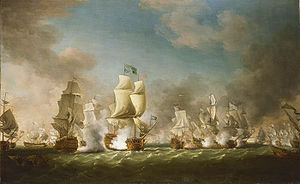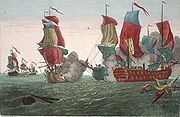
Richard Paton
Encyclopedia

United Kingdom
The United Kingdom of Great Britain and Northern IrelandIn the United Kingdom and Dependencies, other languages have been officially recognised as legitimate autochthonous languages under the European Charter for Regional or Minority Languages...
marine painter.
Paton spent his artistic career in London
London
London is the capital city of :England and the :United Kingdom, the largest metropolitan area in the United Kingdom, and the largest urban zone in the European Union by most measures. Located on the River Thames, London has been a major settlement for two millennia, its history going back to its...
, where he is said to have been born, although no record of his birthplace or parentage is known. He is said to have grown up in poverty, and he is described as "self-taught". Some critics have discerned an influence of Samuel Scott's works, and also of Charles Brooking
Charles Brooking
Charles Brooking was an English painter of marine scenes.-Life:It is highly probable that Brooking’s father was a Charles Brooking who was recorded as employed by Greenwich Hospital between 1729 and 1736 as a painter and decorator. Charles Brooking senior had earlier been active in Plymouth and...
. Any such influence is hardly evident.
According to an account by Harry Parker, in "The Mariner's Mirror", March 1912, p 85, while Paton was begging "on Tower Hill, he attracted the attention of Admiral Sir Charles Knowles (died 1777), who happened to be passing that way, and who, taking a fancy to the boy, offered to take him to sea". He was assistant to the ship’s painter on Knowles' ship, gaining knowledge in both painting and seamanship. In 1742, he started working at the Excise
Excise
Excise tax in the United States is a indirect tax on listed items. Excise taxes can be and are made by federal, state and local governments and are far from uniform throughout the United States...
Office.
His first exhibition was in 1758 on the premises of the London-based Society of Artists
Society of Artists
The Society of Artists of Great Britain was founded in London in May 1761 by an association of artists in order to provide a venue for the public exhibition of recent work by living artists, such as was having success in the long-established Paris salons....
, where he continued to exhibit up to 1770. The Royal Academy
Royal Academy
The Royal Academy of Arts is an art institution based in Burlington House on Piccadilly, London. The Royal Academy of Arts has a unique position in being an independent, privately funded institution led by eminent artists and architects whose purpose is to promote the creation, enjoyment and...
hosted his works between 1762 and 1780.
Paton's specialities were marine and naval paintings. He painted naval actions of wars ongoing at the time of painting such as the Seven Years War of 1756–1763 and later The American Revolutionary War, as well as earlier events such as the battles of the War of the Quadruple Alliance
War of the Quadruple Alliance
The War of the Quadruple Alliance was a result of the ambitions of King Philip V of Spain, his wife, Elisabeth Farnese, and his chief minister Giulio Alberoni to retake territories in Italy and to claim the French throne. It saw the defeat of Spain by an alliance of Britain, France, Austria , and...
which took place when he was a baby.
The paintings include many dramatic effects such as battles at night, the shooting of cannons and the effect of bombardments. There are, however, also less militant themes such as ships becalmed. His "sublime depiction of the sky" was considered especially noteworthy. Prints of his works, made among others by Pierre-Charles Canot
Pierre-Charles Canot
Pierre-Charles Canot, a French engraver, was born about the year 1710, and came in 1740 to England, where he resided during the remainder of his life. He was elected an Associate-Engraver of the Royal Academy in 1770, and died at Kentish Town, near London, in 1777. He engraved a great number of...
, made them widely known.

Among his most well-known works is the Action Between the Serapis
Serapis
Serapis or Sarapis is a Graeco-Egyptian name of God. Serapis was devised during the 3rd century BC on the orders of Ptolemy I of Egypt as a means to unify the Greeks and Egyptians in his realm. The god was depicted as Greek in appearance, but with Egyptian trappings, and combined iconography...
and Bonhomme Richard, depicting the famous confrontation of the British Richard Pearson
Sir Richard Pearson
Sir Richard Pearson was a British naval officer who was captain of the ship HMS Serapis during the American Revolution. He was defeated by John Paul Jones on September 23, 1779 in the Battle of Flamborough Head. As a lieutenant in the East Indies he did well during the Seven Years War, where he...
and the American John Paul Jones
John Paul Jones
John Paul Jones was a Scottish sailor and the United States' first well-known naval fighter in the American Revolutionary War. Although he made enemies among America's political elites, his actions in British waters during the Revolution earned him an international reputation which persists to...
, occurring on 23 September 1779, off Flamborough Head
Flamborough Head
Flamborough Head is a promontory of on the Yorkshire coast of England, between the Filey and Bridlington bays of the North Sea. It is a chalk headland, and the resistance it offers to coastal erosion may be contrasted with the low coast of Holderness to the south...
. It ended with a British defeat; nevertheless, the painting achieved success when included among the prints published within a year of the battle, while the war was still going on, by James Fittler
James Fittler
James Fittler , was an English engraver.Fittler was born in London in 1758, and became a student at the Royal Academy in 1778. Besides book illustrations, he distinguished himself by numerous works after English and foreign masters, chiefly portraits. He engraved also landscapes, marine subjects,...
and Daniel Lerpinière. The painting is at present in the museum of the United States Naval Academy
United States Naval Academy
The United States Naval Academy is a four-year coeducational federal service academy located in Annapolis, Maryland, United States...
at Annapolis.

